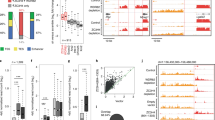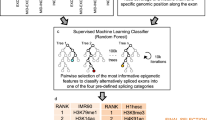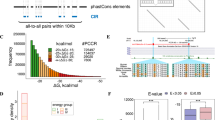Abstract
Chromatin structure influences transcription, but its role in subsequent RNA processing is unclear. Here we present analyses of high-throughput data that imply a relationship between nucleosome positioning and exon definition. First, we have found stable nucleosome occupancy within human and Caenorhabditis elegans exons that is stronger in exons with weak splice sites. Conversely, we have found that pseudoexons—intronic sequences that are not included in mRNAs but are flanked by strong splice sites—show nucleosome depletion. Second, the ratio between nucleosome occupancy within and upstream from the exons correlates with exon-inclusion levels. Third, nucleosomes are positioned central to exons rather than proximal to splice sites. These exonic nucleosomal patterns are also observed in non-expressed genes, suggesting that nucleosome marking of exons exists in the absence of transcription. Our analysis provides a framework that contributes to the understanding of splicing on the basis of chromatin architecture.
This is a preview of subscription content, access via your institution
Access options
Subscribe to this journal
Receive 12 print issues and online access
$189.00 per year
only $15.75 per issue
Buy this article
- Purchase on Springer Link
- Instant access to full article PDF
Prices may be subject to local taxes which are calculated during checkout




Similar content being viewed by others
References
Maniatis, T. & Reed, R. An extensive network of coupling among gene expression machines. Nature 416, 499–506 (2002).
Moore, M.J. & Proudfoot, N.J. Pre-mRNA processing reaches back to transcription and ahead to translation. Cell 136, 688–700 (2009).
Bentley, D.L. Rules of engagement: co-transcriptional recruitment of pre-mRNA processing factors. Curr. Opin. Cell Biol. 17, 251–256 (2005).
Pandit, S., Wang, D. & Fu, X.D. Functional integration of transcriptional and RNA processing machineries. Curr. Opin. Cell Biol. 20, 260–265 (2008).
Kornblihtt, A.R. Coupling transcription and alternative splicing. Adv. Exp. Med. Biol. 623, 175–189 (2007).
Kadener, S. et al. Antagonistic effects of T-Ag and VP16 reveal a role for RNA Pol II elongation on alternative splicing. EMBO J. 20, 5759–5768 (2001).
Batsché, E., Yaniv, M. & Muchardt, C. The human SWI/SNF subunit Brm is a regulator of alternative splicing. Nat. Struct. Mol. Biol. 13, 22–29 (2006).
Sims, R.J., III et al. Recognition of trimethylated histone H3 lysine 4 facilitates the recruitment of transcription postinitiation factors and pre-mRNA splicing. Mol. Cell 28, 665–676 (2007).
Schor, I.E., Rascovan, N., Pelisch, F., Allo, M. & Kornblihtt, A.R. Neuronal cell depolarization induces intragenic chromatin modifications affecting NCAM alternative splicing. Proc. Natl. Acad. Sci. USA 106, 4325–4330 (2009).
Das, R. et al. SR proteins function in coupling RNAP II transcription to pre-mRNA splicing. Mol. Cell 26, 867–881 (2007).
Phatnani, H.P. & Greenleaf, A.L. Phosphorylation and functions of the RNA polymerase II CTD. Genes Dev. 20, 2922–2936 (2006).
Nogues, G., Kadener, S., Cramer, P., Bentley, D. & Kornblihtt, A.R. Transcriptional activators differ in their abilities to control alternative splicing. J. Biol. Chem. 277, 43110–43114 (2002).
Auboeuf, D., Honig, A., Berget, S.M. & O'Malley, B.W. Coordinate regulation of transcription and splicing by steroid receptor coregulators. Science 298, 416–419 (2002).
Monsalve, M. et al. Direct coupling of transcription and mRNA processing through the thermogenic coactivator PGC-1. Mol. Cell 6, 307–316 (2000).
Li, X. & Manley, J.L. Cotranscriptional processes and their influence on genome stability. Genes Dev. 20, 1838–1847 (2006).
Luna, R., Gaillard, H., Gonzalez-Aguilera, C. & Aguilera, A. Biogenesis of mRNPs: integrating different processes in the eukaryotic nucleus. Chromosoma 117, 319–331 (2008).
Lin, S., Coutinho-Mansfield, G., Wang, D., Pandit, S. & Fu, X.D. The splicing factor SC35 has an active role in transcriptional elongation. Nat. Struct. Mol. Biol. 15, 819–826 (2008).
de la Mata, M. et al. A slow RNA polymerase II affects alternative splicing in vivo. Mol. Cell 12, 525–532 (2003).
Howe, K.J., Kane, C.M. & Ares, M. Jr. Perturbation of transcription elongation influences the fidelity of internal exon inclusion in Saccharomyces cerevisiae. RNA 9, 993–1006 (2003).
Muñoz, M.J. et al. DNA damage regulates alternative splicing through inhibition of RNA polymerase II elongation. Cell 137, 708–720 (2009).
Allo, M. et al. Control of alternative splicing through siRNA-mediated transcriptional gene silencing. Nat. Struct. Mol. Biol. 16, 717–724 (2009).
Fraser, P. & Bickmore, W. Nuclear organization of the genome and the potential for gene regulation. Nature 447, 413–417 (2007).
Kouzarides, T. Chromatin modifications and their function. Cell 128, 693–705 (2007).
Allemand, E., Batsche, E. & Muchardt, C. Splicing, transcription, and chromatin: a ménage à trois. Curr. Opin. Genet. Dev. 18, 145–151 (2008).
Beckmann, J.S. & Trifonov, E.N. Splice junctions follow a 205-base ladder. Proc. Natl. Acad. Sci. USA 88, 2380–2383 (1991).
Denisov, D.A., Shpigelman, E.S. & Trifonov, E.N. Protective nucleosome centering at splice sites as suggested by sequence-directed mapping of the nucleosomes. Gene 205, 145–149 (1997).
Kogan, S. & Trifonov, E.N. Gene splice sites correlate with nucleosome positions. Gene 352, 57–62 (2005).
Schones, D.E. et al. Dynamic regulation of nucleosome positioning in the human genome. Cell 132, 887–898 (2008).
Valouev, A. et al. A high-resolution, nucleosome position map of C. elegans reveals a lack of universal sequence-dictated positioning. Genome Res. 18, 1051–1063 (2008).
Schwartz, S., Meshorer, E. & Ast, G. Chromatin organization marks exon-intron architecture. Nat. Struct. Mol. Biol. advance online publication, doi:10.1038/nsmb.1659 (16 August 2009).
Kolasinska-Zwierz, P. et al. Differential chromatin marking of introns and expressed exons by H3K36me3. Nat. Genet. 41, 376–381 (2009).
Sammeth, M., Foissac, S. & Guigo, R. A general definition and nomenclature for alternative splicing events. PLOS Comput. Biol. 4, e1000147 (2008).
Wang, E.T. et al. Alternative isoform regulation in human tissue transcriptomes. Nature 456, 470–476 (2008).
Barski, A. et al. High-resolution profiling of histone methylations in the human genome. Cell 129, 823–837 (2007).
Kharchenko, P.V., Woo, C.J., Tolstorukov, M.Y., Kingston, R.E. & Park, P.J. Nucleosome positioning in human HOX gene clusters. Genome Res. 18, 1554–1561 (2008).
Peckham, H.E. et al. Nucleosome positioning signals in genomic DNA. Genome Res. 17, 1170–1177 (2007).
Harrow, J. et al. GENCODE: producing a reference annotation for ENCODE. Genome Biol. 7 (Suppl 1), S4 (2006).
Berget, S.M. Exon recognition in vertebrate splicing. J. Biol. Chem. 270, 2411–2414 (1995).
Das, R. et al. Functional coupling of RNAP II transcription to spliceosome assembly. Genes Dev. 20, 1100–1109 (2006).
Ikemura, T. Correlation between the abundance of yeast transfer RNAs and the occurrence of the respective codons in protein genes. Differences in synonymous codon choice patterns of yeast and Escherichia coli with reference to the abundance of isoaccepting transfer RNAs. J. Mol. Biol. 158, 573–597 (1982).
Kotlar, D. & Lavner, Y. The action of selection on codon bias in the human genome is related to frequency, complexity, and chronology of amino acids. BMC Genomics 7, 67 (2006).
Jabbari, K., Clay, O. & Bernardi, G. GC3 heterogeneity and body temperature in vertebrates. Gene 317, 161–163 (2003).
Katz, L. & Burge, C.B. Widespread selection for local RNA secondary structure in coding regions of bacterial genes. Genome Res. 13, 2042–2051 (2003).
Duret, L. Detecting genomic features under weak selective pressure: the example of codon usage in animals and plants. Bioinformatics 18 (Suppl 2), S91 (2002).
Willie, E. & Majewski, J. Evidence for codon bias selection at the pre-mRNA level in eukaryotes. Trends Genet. 20, 534–538 (2004).
Pruitt, K.D., Tatusova, T. & Maglott, D.R. NCBI reference sequences (RefSeq): a curated non-redundant sequence database of genomes, transcripts and proteins. Nucleic Acids Res. 35, D61–D65 (2007).
Benson, D.A., Karsch-Mizrachi, I., Lipman, D.J., Ostell, J. & Wheeler, D.L. GenBank. Nucleic Acids Res. 36, D25–D30 (2008).
Kent, W.J. et al. The human genome browser at UCSC. Genome Res. 12, 996–1006 (2002).
Blanco, E., Parra, G. & Guigo, R. Using geneid to identify genes. Curr. Protoc. Bioinformatics, Chapter 4: Unit 4.3 (2007).
Parra, G., Blanco, E. & Guigo, R. GeneID in Drosophila. Genome Res. 10, 511–515 (2000).
Sheth, N. et al. Comprehensive splice-site analysis using comparative genomics. Nucleic Acids Res. 34, 3955–3967 (2006).
Alioto, T.S. U12DB: a database of orthologous U12-type spliceosomal introns. Nucleic Acids Res. 35, D110–D115 (2007).
Acknowledgements
We thank D.E. Schones for help with the data and its interpretation and members of the Guigó laboratory, especially D. Gonzalez, for help with data analysis. This work was supported by the Spanish Ministry of Science with fellowships to M.S. and S.A., and with grant number BIO2006-03380 to R.G.
Author information
Authors and Affiliations
Corresponding author
Supplementary information
Supplementary Text and Figures
Supplementary Figures 1–6 and Supplementary Methods (PDF 2088 kb)
Rights and permissions
About this article
Cite this article
Tilgner, H., Nikolaou, C., Althammer, S. et al. Nucleosome positioning as a determinant of exon recognition. Nat Struct Mol Biol 16, 996–1001 (2009). https://doi.org/10.1038/nsmb.1658
Received:
Accepted:
Published:
Issue Date:
DOI: https://doi.org/10.1038/nsmb.1658
This article is cited by
-
Genome surveillance by HUSH-mediated silencing of intronless mobile elements
Nature (2022)
-
Genomic competition for noise reduction shaped evolutionary landscape of mir-4673
npj Systems Biology and Applications (2020)
-
The chromatin remodeler ZmCHB101 impacts alternative splicing contexts in response to osmotic stress
Plant Cell Reports (2019)
-
Deep learning architectures for prediction of nucleosome positioning from sequences data
BMC Bioinformatics (2018)
-
Molecular basis of differential 3′ splice site sensitivity to anti-tumor drugs targeting U2 snRNP
Nature Communications (2017)



